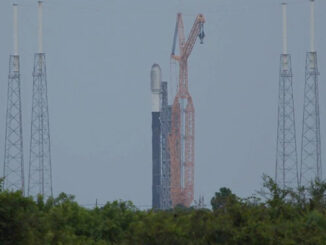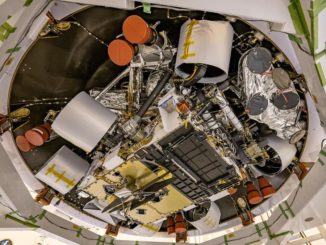
A SpaceX Dragon supply ship arrived at the International Space Station Saturday carrying a new docking mechanism, a spacesuit for future spacewalks, and a 3D bioprinter to test the feasibility of manufacturing human tissue in microgravity.
Astronaut Nick Hague, at the controls of the space station’s Canadian-built robotic arm, grappled the Dragon cargo craft at 9:11 a.m. EDT (1311 GMT) Saturday as the complex soared 267 miles (429 kilometers) over the coast of southern Chile.
The Dragon spacecraft delivered 5,097 pounds (2,312 kilograms) of supplies, equipment and research investigations for the station’s six-person Expedition 60 crew.
“I want to congratulate the team across the globe that makes delivering a vehicle like this — it’s pretty looking at it out the window — to the station with science and cargo and things to keep us busy, so the mission continues,” Hague said in a transmission to mission control.
Ground controllers took command of the robotic arm later Saturday to maneuver the Dragon spacecraft to a berthing port on the space station’s Harmony module, where 16 bolts drove closed to firmly connect the cargo ship to the orbiting research outpost.
The station planned to open hatches Sunday leading into the newly-arrived cargo freighter to begin unpacking the ship’s pressurized compartment.
Capture!
Today my crewmate @AstroHague and I captured the @SpaceX #Dragon, filled with over 5,000 pounds of science and supplies. Still celebrating Apollo anniversaries on @Space_Station with the #Apollo50th emblem on the Dragon vehicle. Can you spot it? pic.twitter.com/f8YviJDBBW
— Christina H Koch (@Astro_Christina) July 27, 2019
The Dragon spacecraft arrived at its destination Saturday is on its third mission to the space station, following previous trips into orbit in 2015 and 2017. It’s the first time SpaceX has flown a Dragon capsule three times.
The automated cargo carrier lifted off Thursday atop a Falcon 9 rocket from Cape Canaveral.
“We’ve got about 5,000 pounds of science, critical spares, food and other items on this flight, also including, externally, the International Docking Adapter No. 3,” said Bill Spetch, NASA’s deputy manager of space station transportation integration, in a pre-launch press conference. “We’re really looking forward to getting this on there. It’s an important piece of hardware for the future of ISS as it sets the stage for how we are going operate with commercial crew vehicles and our partners in the future.”
The third International Docking Adapter, or IDA-3, will accommodate the Crew Dragon and Starliner commercial crew ferry ships in development by SpaceX and Boeing.
IDA-3 was built by Boeing to replace a unit lost during a SpaceX launch failure in 2015. SpaceX successfully delivered IDA-2 to the station in 2016, and the new docking mechanism was first used in March by SpaceX’s Crew Dragon spacecraft on an unpiloted test flight before officials clear astronauts to ride the vehicle.
NASA said in 2016 it was paying Boeing $9 million to construct the replacement docking adapter using spare parts left over from the first two units.
The space station’s robotic arm will pull IDA-3 out of the Dragon cargo capsule’s unpressurized aft payload bay and place it on the space-facing zenith port of the space station’s Harmony module in mid-August, allowing Boeing’s Starliner and SpaceX’s Crew Dragon capsules to park at the station at the same time, using two separate docking adapters.
“As we rotate crews through the vehicle, we want to have them time to directly hand over face-to-face, so enabling those two docked vehicles is very important,” Spetch said.
The new docking mechanisms are designed for attachment to the station’s space shuttle-era docking ports. The Crew Dragon and Starliner spacecraft employ a different docking system design than the shuttle.
Two astronauts will head outside the station next month to finish up connections between IDA-3 and the Harmony module.

A habitat carrying 40 female mice also launched inside SpaceX’s Dragon spacecraft. The capsule will return to Earth from its month-long mission with 20 of the mice, and specimens from the mice will distributed to medical and biological researchers to investigate how spaceflight affected the animals’ muscles, bones, immune systems and organs.
The other 20 mice will remain on the station to undergo longer exposure to microgravity.
NASA also placed a spacesuit inside the Dragon cargo craft’s pressurized module for use by astronauts on spacewalks.
Here is a breakdown of the cargo aboard the Dragon spacecraft:
- Science Investigations: 2,628 pounds (1,192 kilograms)
- Crew Supplies: 514 pounds (233 kilograms)
- Spacewalk Equipment: 394 pounds (179 kilograms)
- Vehicle Hardware: 345 pounds (157 kilograms)
- Computer Resources: 38 pounds (17 kilograms)
- Unpressurized Payloads (IDA-3): 1,177 pounds (534 kilograms)
Other items delivered to the station inside Dragon’s pressurized compartment include a 3D BioFabrication Facility developed by Techshot, an Indiana-based company, to demonstrate printing soft human tissue in microgravity, a capability researchers view as a stepping stone toward potentially manufacturing organs for transplant patients.

Goodyear Tire and Rubber Co. also has an experiment on the Dragon supply ship. The tire manufacturer will study the formation of silica fillers, a common material used in consumer tires, in the microgravity environment of Earth orbit.
According to Goodyear, knowledge gained from the experiment will help engineers evaluate potential improvements to the silica design process and rubber formulation.
“Goodyear has been a pioneer in tire innovations related to space, with the first and only tires on the moon, numerous projects with NASA and now this,” said Eric Mizner, Goodyear’s director of global materials science, in a press release. “It underscores our passion for going to the ends of the earth — and beyond — to develop new technologies that help us deliver breakthrough products with true consumer benefits.”
Results from the space station experiment may yield improvements in fuel efficiency and other tire performance factors, according to Goodyear.
Japanese scientists also sent up an experiment to grow moss in space, seeking to compare how the plant grows in space with its behavior on Earth. Mosses could be used as a food or oxygen source on future space missions, such as bases on the moon or Mars.
The mission is SpaceX’s 18th flight to resupply the space station under a $3.04 billion cargo transportation contract with NASA. First signed in 2008, the deal covers 20 resupply missions.
SpaceX also holds separate multibillion-dollar NASA contracts for additional supply deliveries in the early 2020s, and for the development of the Crew Dragon, or Dragon 2, capsule designed to carry both cargo and astronauts.
The upgraded Dragon 2 vehicle is capable of docking directly to the space station, without relying on the robotic arm to capture it. SpaceX plans to begin using a cargo variant of the Dragon 2, similar in design to the human-rated Crew Dragon, for resupply missions next year, resulting in the retirement of the current Dragon design.
The Dragon spacecraft that arrived at the station Saturday is scheduled to depart the international research complex Aug. 27 and head for splashdown in the Pacific Ocean, returning home with research specimens and another spacesuit that requires refurbishment.
Email the author.
Follow Stephen Clark on Twitter: @StephenClark1.



